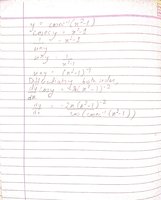You are using an out of date browser. It may not display this or other websites correctly.
You should upgrade or use an alternative browser.
You should upgrade or use an alternative browser.
Please tell me if this is the correct way of solving this problem.
- Thread starter tikA
- Start date
D
Deleted member 4993
Guest
You did not tell us what you wanted to FIND !!
You calculated dy/dx correctly.
Sorry. Yeah the question was to find dy/dx. I was confused since there was a direct formula as well d/dxcsc-1(x)=-1/|x| sqrt(x2-1) but that made no sense for this problemYou did not tell us what you wanted to FIND !!
You calculated dy/dx correctly.
Steven G
Elite Member
- Joined
- Dec 30, 2014
- Messages
- 14,603
You are getting so picky lately.You did not tell us what you wanted to FIND !!
Davey Jones
New member
- Joined
- Apr 29, 2021
- Messages
- 4
Assuming you are looking for dy/dx, looks ok. However, leaving cos(cosec-1(x2-1)) is usually considered unfinished, because the expression can be written algebraically, without the need for trig functions.
imagine an angle in a right triangle whose hypotenuse is length x2-1 and whose opposite side is length 1. The adjacent side would be x SQRT(x2-2). The cosecant of this angle equals x2-1, and hence that angle’s measure is cosec -1(x2-1). Cosine of this angle would equal
x SQRT(x2-2)/(x2-1).
imagine an angle in a right triangle whose hypotenuse is length x2-1 and whose opposite side is length 1. The adjacent side would be x SQRT(x2-2). The cosecant of this angle equals x2-1, and hence that angle’s measure is cosec -1(x2-1). Cosine of this angle would equal
x SQRT(x2-2)/(x2-1).
[MATH]|x| \sqrt{x^2-2}[/MATH]The adjacent side would be x SQRT(x2-2)
Dr.Peterson
Elite Member
- Joined
- Nov 12, 2017
- Messages
- 16,872
Why does it make no sense? You can do it that way and get the same result as your way yields (after simplifying the cosine to an algebraic expression).Sorry. Yeah the question was to find dy/dx. I was confused since there was a direct formula as well d/dxcsc-1(x)=-1/|x| sqrt(x2-1) but that made no sense for this problem
how do i simplify cosine to algrebraic expression?Why does it make no sense? You can do it that way and get the same result as your way yields (after simplifying the cosine to an algebraic expression).
Dr.Peterson
Elite Member
- Joined
- Nov 12, 2017
- Messages
- 16,872
how do i simplify cosine to algebraic expression?
Did you read #5? Davey Jones left out some steps, so you may not immediately follow his work. But you have probably seen problems like this.
Draw a right triangle and mark angle \(\theta\), whose cosecant is \(x^2-1\). Label an appropriate side 1 and another \(x^2-1\), then use the Pythagorean theorem to label the third. Write an expression for \(\cos(\theta)\) in terms of x.

